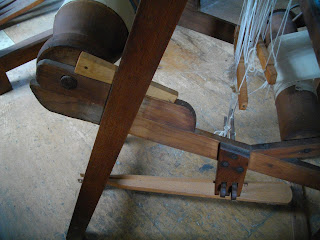 |
| Weaving House |
It was a cold day, but it wasn't raining, so my family and I got to wander freely among the buildings and shops and had plenty of time to talk to the docents about their trades and pick their brains for historic knowledge.
I was there for the weaving looms. I live 90 minutes away, but only visit every two years. I wrote a book on band weaving a few years ago, and I acquired my barn loom from Minnesota just last year to make rag rugs, so I was looking forward to the Shaker weaving building. Yes! Imagine having a big beautiful building... two stories high with just weaving equipment and yarn!
Heaven!
Since we were of only 30 or so visitors this day, my granddaughter, Isobel, who is 9, got to weave a chair seats with the docent. Fortunate for me, I have two daughters and three granddaughters who love all the stuff that I love and are constantly absorbing knowledge from the craftsmen and women that we meet so often in our travels to history museums, shops, fairs and festivals.
The Shakers wove bands for woven chair seats twice. Once to weave the bands themselves on small floor looms and again weaving the bands onto the chair itself. Isobel's chair is clamped to a wall and she is able to turn the chair as she weaves over the top and then the bottom. There are several weave patterns for the chair themselves, but also hundreds of patterns and colors on the bands.
She is using a large wooden needle to weave the chair seat as the pattern gets tighter. The seat has a cushion of foam to help support the weave, but in the past the weavers used pads of rags, horse fibers and paper.

Then we went to the weaving building. I was looking for a gate, paddle or box loom for the bands made for the chairs. I found none here. The Shakers were English. The English that immigrated to America used gate, paddle and box looms for their tapes and bands. I found this wonderful little floor loom and now realize that this would be a better loom to weave a long band for the chair seats. Each chair seat needs about 50 feet of band. Although you certainly do not need to weave 50 feet at a time. When using a gate, paddle or box loom, even 10 feet of warp is a lot to manage on these smaller looms. This Shaker loom at the museum could be conveniently set up for yards of warp.
Then I concentrated on photos of the big barn looms. My barn loom came in pieces and it wasn't much for Roger and I to figure out it is set up. However, our loom, built in the late 1800s had even older pulleys. My loom had hand carved pulleys., probably brought over from Scandinavia. The set up looked like they were made for 4 heddles. My loom only had two heddles, and as I wanted to only make rugs, two heddles were fine for me. But we had to figure a way to incorporate our beautiful pulleys into a two heddle set-up.
The Shaker museum had over 6 barn looms, many with pulleys.
And the rugs they made were wonderful! Throughout the village, there were throw rugs and room size rugs... strips about 30 inches wide sewn together. I especially liked the zig-zag patterns. Rugs made by twisting 3 color rag strips together in an "S" twist or a "Z" twist to create this unique effect.



Amazon sells a book on how to make this pattern....
Check out my Pinterest pages to see many hand-made band looms, barn looms and weaving done on them and then go be creative!
https://www.pinterest.com/potterymom1/weaving-band-looms/
https://www.pinterest.com/potterymom1/barn-looms/
https://www.pinterest.com/potterymom1/weaving-bands-tapes/
https://www.pinterest.com/potterymom1/woven-rugs/
And, of course, if you get the time and are near Massachusetts, stop and visit the Hancock Shaker Museum to see the weaving and looms up close.






























































